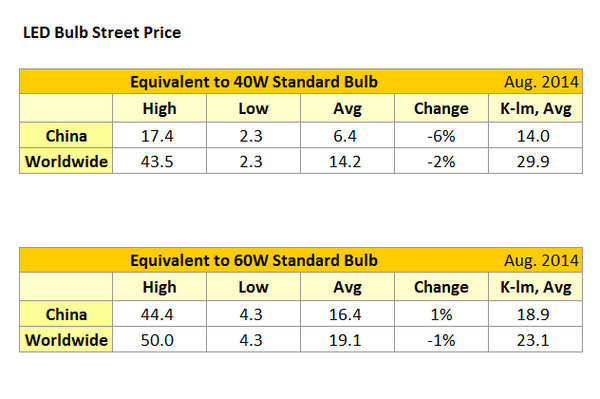The global average sales price (ASP) for LED bulbs declined by 1.8 percent in August as the market stabilized, according to LEDinside, a subsidiary of the Taiwan-based market intelligence firm TrendForce. Regionally, LED bulb prices declined the most in Japan.
Globally, 40W equiv. LED bulb retail prices dipped by 1.8% to $14.2 in August 2014, while prices for 60W equivalent (equiv.) LED bulbs were also down 0.9% last month to $19.1. For 40W equiv. LED bulbs, retail prices fell most sharply in the UK last month, declining by 4.7%.
 |
|
(Source: LEDinside) |
Existing product retail prices declined steadily, with some decreasing more markedly than others. For instance, Toshiba’s 7.7W LED bulbs dropped from $23.6 to $12.5 in August. Bulb prices in Germany were also down 2.6 percent during the same period. Retail prices for LED bulbs on the market fell slightly or stabilized, while fluctuations in currency exchange caused LED bulbs’ ASP to drop in Germany.
In the Japanese market, the 40W equiv. LED ASP rose 0.3 percent, while products already in stores fluctuated slightly. New lighting product prices were in the higher price range. For example, Mitsubishi Electric’s 6W LED bulb with a luminous flux of 500LM retailed for $17. In contrast, 40W equiv. LED bulb prices were up 0.9% in the U.S. in August. Notably, retail prices for Cree’s 6W LED bulb surged from $4.97 to $8.97.
Japan again showed the largest price drops for 60W equiv. LED bulbs last month, with prices down 8.5 percent to $16.8. Some product prices in the country declined more than others. For instance, Mitsubishi Electric’s 11.4W bulb prices fell from $18.3 to $11.8. Currency fluctuations also sent the LED bulb ASP plunging in the Japanese market.
That situation stood in stark contrast to the one in the US, where LED bulb prices shot up 5.5 percent. A number of manufacturers raised prices. For example, Philips 11W 830LM bulb prices increased from $7.6 to $13 in the U.S. market. LED bulb prices in China and Taiwan also increased 0.7 percent and 0.1 percent respectively. LED bulb prices in both markets have been stable, with changes in currency exchange rates the main reason for incremental price upticks.












